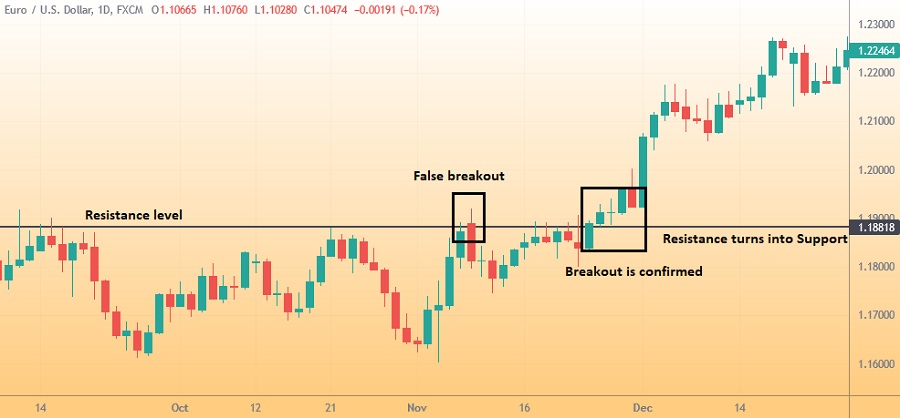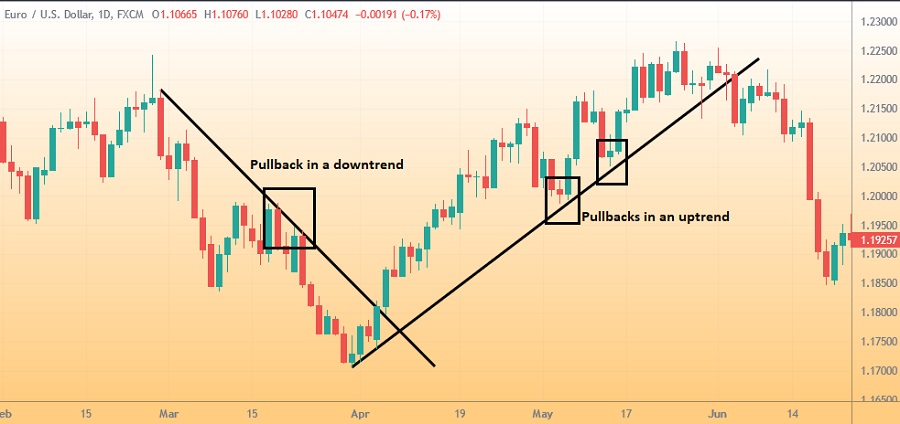Breakouts and pullbacks are very common and can provide good opportunities to enter the market profitably. Let's figure out how to trade them crorrectly.
Although there are countless trading strategies in the forex market with each of them using different techniques, there is one thing that's almost certain. When you enter a trade, you're doing it during a breakout or a pullback. It's just a given, there's no denying it. You may not know that this is what you're doing simply because you have no idea what even a breakout or a pullback is. We can almost guarantee that once you understand what these terms even mean, you'll realize that this is exactly what you've been doing this entire time. Below we'll go into more detail on what these terms mean, how to trade in these conditions, and if doing so is even worth it.

Contents
Defining Breakouts
A breakout occurs when the price of an asset crosses above the last resistance level or below the last support level. A resistance level can be found by finding the highest points in the last couple of candlesticks. Similarly, the support levels can be found by finding the lowest points in the last couple of candlesticks. Most people trade breakouts without even realizing it. You'll often be watching the market and waiting for a good opportunity to execute a trade. Once you realize that the price of the asset is lower than usual or higher than usual, you'll find yourself entering a trade immediately. By doing so, you would've just traded in a breakout.
How to Trade Breakouts
Before we get into how to trade breakouts, it is important to note that although this is quite a popular trading strategy, there is still a chance for it to fail, or in other words, for the breakout to turn into a false breakout. But if the breakout does happen, your resistance level will turn into a support level and vice versa. Now that we've got that out of the way, let's look at how to trade breakouts in a long trade and a short trade.

- Long Trade
A long trade is where you enter a position as a BUY deal. In order to trade breakouts in a long trade, you need to first identify if the market is starting to move in an ascending direction. Once you've got that covered, you need to identify what is the resistance level. If the price exceeds the resistance level while moving in an ascending pattern, you can enter the trade through a breakout. This is how you trade breakouts in a long trade. - Short Trade
A short trade is where you enter a position as a SELL deal. In order to trade breakouts in a short trade, you need to first identify if the market is looking to move in a descending pattern. Once this is identified, you can look towards finding out the support level for this asset. if the price of the asset exceeds the support level while moving downwards, you can enter the trade through a breakout. This is how you trade breakouts in a short trade.
Should You Trade Breakouts?
You should absolutely trade breakouts. In fact, you most probably are trading breakouts without realizing it. The greatest part about trading using breakouts is that you're constantly moving along with the momentum of the market as well. You will almost certainly catch the market having a moment where the price suddenly breaks away from the normal trend. Therefore this strategy is readily available to be used at almost all times. One thing to look out for is if you do end up trading with breakouts, you will experience false breakouts more than you think. It is, therefore, crucial to set up a stop loss to prevent any major losses.
Defining Pullbacks
A pullback is when the market faces temporary moments where the price goes against the current market trends. This can be if the price suddenly drops for a short while when the market is following an ascending pattern. Similarly, this can also be when the price increases suddenly for a short period of time when the market is following a descending pattern.

Pullbacks are great opportunities for traders to enter a market at a decent price if they had been unsuccessful at doing so previously. This is also a popular trading strategy that is being practiced by people of all specialties. However, if you don't know this strategy by name, it is crucial to take in every last detail of an asset before executing the pullback trade.
See Also:
How to Trade Pullbacks
Before we begin on how to trade pullbacks in both the long trade and short trade conditions, we need to understand that there's a good chance that we may experience false signals. It is, therefore, crucial for anyone using the pullback strategy to at least place stop losses in order to prevent any major losses. Now let's look at how to trade pullbacks in both the long trades and short trades.
- Long Trade
In order to trade a pullback in a long trade, you need to first identify if the market is bullish or if it's moving in an ascending direction. Once this is identified, we need to wait for a candle to pull back from its regular route. This candle will drop below the trending pattern more than usual. This is our cue to execute the deal. This is how you execute pullbacks in a long trade. - Short Trade
In order to trade a pullback in a short trade, you need to watch the market and find out if the market is moving in a descending pattern. Once this pattern is identified, we need to wait for a candle to shoot up from its regular route. This candle will rise higher than usual. This would be our cue to execute the deal. This is how you execute pullbacks in a short trade.
Should You Trade Pullbacks?
There is no reason why you shouldn't trade pullbacks. You get to place an order at one of the best market timing, therefore giving you gold for your buck. The only thing you need to look out for is that you shouldn't be greedy. Sometimes waiting for the candlestick to go much farther from its original route can make you lose the position entirely.
Did you know that trading pullbacks is one of the most recommended trend-following strategies? Why do you have to follow the trend and are there other ways to confirm if the trend will continue? Find the answers in 3 Best Ways to Confirm Trend Continuation.

 Dedicated FREE FOREX VPS
Dedicated FREE FOREX VPS Free FOREX Virtual Private Server
Free FOREX Virtual Private Server MT4 Demo Contest, Get $500
MT4 Demo Contest, Get $500 Sign Up for an Account, Claim 60% Deposit Bonus
Sign Up for an Account, Claim 60% Deposit Bonus Free MT4/MT5 VPS 2024
Free MT4/MT5 VPS 2024 Send E-mail and Get Free Merchandise
Send E-mail and Get Free Merchandise $1K Refer a Friend Bonus for Pepperstone Pro clients
$1K Refer a Friend Bonus for Pepperstone Pro clients Maximize Your Earnings with 100% Deposit bonus
Maximize Your Earnings with 100% Deposit bonus Trade to Win, $5,000 Monthly Demo Contest
Trade to Win, $5,000 Monthly Demo Contest Claim 30% + 15% Deposit Bonus from LiteFinance
Claim 30% + 15% Deposit Bonus from LiteFinance











